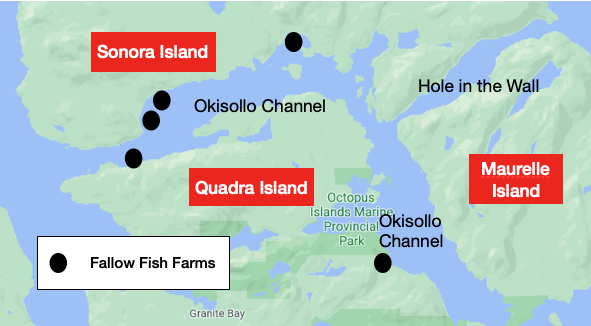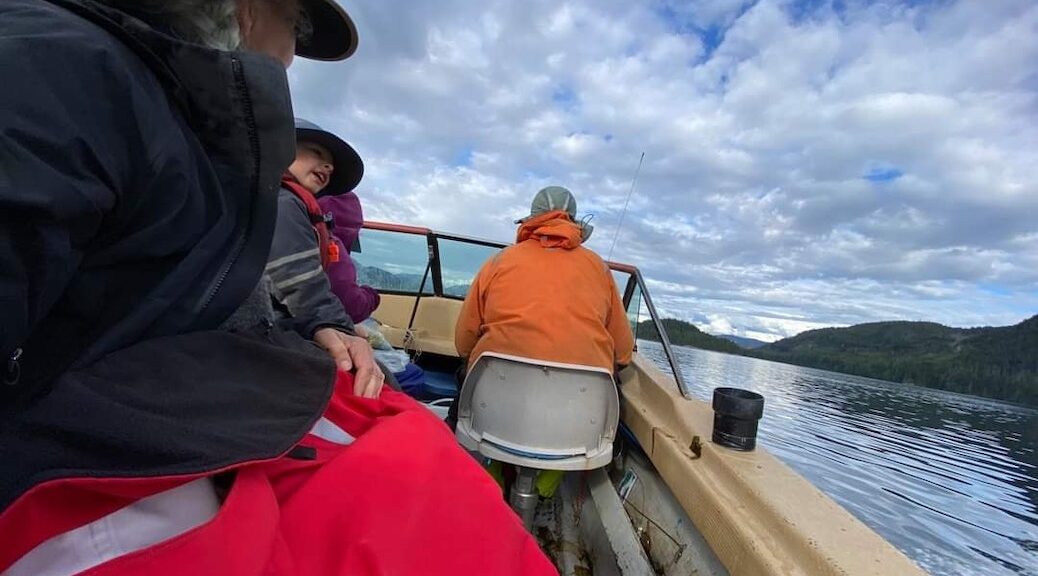Now that most of the fish farms in the Discovery Islands have closed down, sea lice numbers may have plummeted as much as 95%.
Sea Lice numbers allegedly plummeted 95%
“Most of the salmon farms are empty; All of the farms south of Chatham Point are empty. Sea lice levels have plummeted over 95%. The Pink and Chum Salmon look gorgeous. This is due to the Minister’s decision and the seven First Nations who prohibited her from restocking the salmon farm,“ said independent biologist Alexandra Morton, who returned home to Sointula Friday afternoon.
Cortes Currents first learned that there is no longer a sea lice problem on Wednesday, May 26th, when Angela Koch of Sierra Quadra gave the Strathcona Regional District Board a report from the Okisollo Channel, which separates Quadra from Sonora and Maurelle Islands.
“On Sunday I talked to a couple of people who monitor, they test the smolts for sea lice every year. They said they’ve seen a 95% reduction in sea lice. So last year each smolt that they caught had an average of 9 sea lice on them. This year, there was a total of 9 sea lice on 50 fish,” she said.
These findings follow on last year’s report that the number of sea lice in the Broughton Archipelago, where fish farms are closing down, was significantly lower than areas where fish farms are still active.
Those are my numbers
“Those are my numbers,” said Morton.
Since April 1st, Morton says she has examined over 1,000 fish in the Discovery Islands and another 400 to 500 in Nootka Sound and Esperanza on the West Coast of Vancouver Island, “where the story is very different.”
“Last year, 50% of the farms went over the 3 adult lice limit. This was a limit that was set in 2003, by the Provincial Government, to protect wild salmon. The sea lice outbreak was horrendous. The sockeye had an average of 9 lice per fish, which we know from the DFO’s own research would have had profound impact on them,” she said.
Morton cited a 2018 study by Dr Simon Jones and two other scientists from the Pacific Biological Station in Nanaimo, “which found that when young sockeye get infected with sea lice, basically they couldn’t keep the salt out of their bodies. They had a huge glucose spike, which is a serious stress response.”

The Okisollo Channel
“One of the things that I realized now, with the farms all out of the Okisollo Channel, which is a very short body of water with a narrow ending at both ends, is that all three Norwegian companies were operating in that little body of water. There were four farms. This is the highest density of salmon farms anywhere on this coast and it is the only place where all three companies decided to operate side by side. You could not have picked a worse place because millions of salmon from the Fraser River funnel through those waters,” said Morton.
“I’ve been doing this work on and off since 2005, with the incredible assistance of Jody Erickson and Farlyn Campbell from Sonora island. Those two are incredible fishermen. They have these nets that we use to collect the fish. Sometimes we look at them alive’ sometimes we have to freeze them. In any case, I have looked at a lot of fish since 2005: a thousand this year, hundreds last year. The difference is so obvious, there is no mistaking it.”
Debate at the SRD Board meeting
At the last SRD Board meeting, Campbell River Director Charlie Cornfield asked Sierra Quadra, “Do you believe that wild salmon recovery will bounce back if the fish farms are removed?”
Bonnie Brownstein, of Sierra Quadra replied, “Yes, we do believe that. Populations already are bouncing back in the Okisollo.”
To which Cornfield responded, “ No, the (…) report was based on the number of sea lice seen on the small fish now versus last year, [This] does not make the recovery of a fish population any more viable.”
“If the juvenile salmon don’t have the sea lice, then they are more likely to survive. That’s what is happening now. They are surviving, to get to the Fraser,” said Brownstein.
“But not to adulthood.” Cornfield pointed out.
“We don’t know that yet, the season isn’t that far along,” laughed Brownstein.
(Cornfield and two other Campbell River Directors opposed ‘receiving’ the Sierra Quadra presentation, but were outvoted by the rest of the SRD Board.)

Facebook campaign
Alexandra Morton, and Sonora Island photographer Tavish Campbell, have started a campaign on her Facebook page showing what the fish looked like in 2020 and 2021.
“I’ve been looking at sea lice on juvenile salmon for around 21 years and to just see the sheer beauty of the fish! They are fat and they are going to survive- at least to get to the sea! I do not now what is going to happen to them there, but they are at least getting by Campbell River. The impact is instantaneous.”
As this story essentially broke over the weekend, Cortes Currents has not had time to hear from industry and hopes to publish their response separately.
Links of Interest:
- (Cortes Currents)SRD will not support DFO decision
- (Cortes Currents) articles about sea lice
- (Journal of Aquatic Animal Health) Differential Effects of Adult Salmon Lice Lepeophtheirus salmonis on Physiological Responses of Sockeye Salmon and Atlantic Salmon
- (Alexandra Morton) Sea Lice Survey Four Regions of BC Coast 2020 – Preliminary Report
- Alexandra Morton’s Facebook page
- (Cortes Currents) articles about or mentioning fish farms in the Discovery Islands

Photo credits: top and podcast images: courtesy Alexandra Morton; chart from Sea Lice Survey Four Regions of BC Coast 2020 – Preliminary Report Prepared by Alexandra Morton; Map of fallow fish farms drawn up from MOWI, Cermaq and Grieg materials and prepared by Roy L Hales; “Sea Lice underreported” links to an SFU news release and taken from Sierra Quadra presentation to the SRD Board; Removing Fish farms works – courtesy Alexandra Morton; Pink salmon from Okisollo Channel – Preliminary Report, Morton
Sign-up for Cortes Currents email-out:
To receive an emailed catalogue of articles on Cortes Currents, send a (blank) email to subscribe to your desired frequency:
- Daily, (articles posted during the last 24 hours) – cortescurrents-daily+subscribe@cortes.groups.io
- Weekly Digest cortescurrents – cortescurrents-weekly+subscribe@cortes.groups.io




One thought on “Sea lice numbers plummeted 95% in Discovery Islands, scientist says”
Comments are closed.